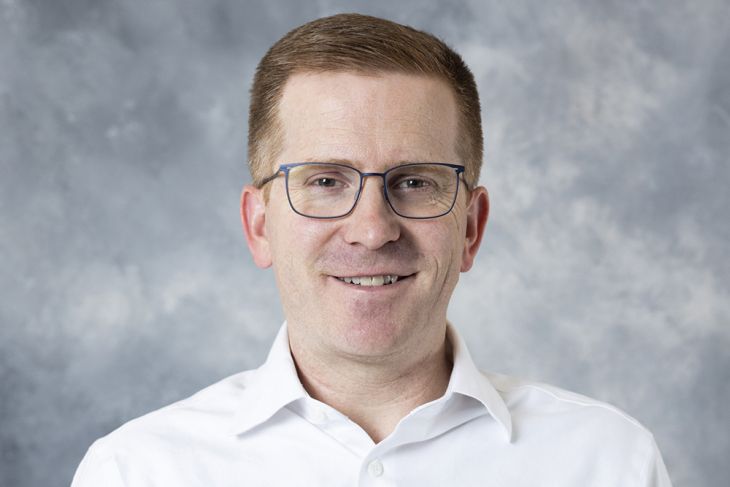Something new, large, and round has dominated the Las Vegas skyline since July: Sphere.
After debuting this summer, the state-of-the-art entertainment venue became instantly recognizable thanks to pictures and videos on social media and Reddit. Some of the most viral posts depict the 580,000-square-foot, fully programmable LED Exosphere projecting a giant yellow emoji that smiles, sleeps, and follows airplanes flying overhead with a look of wonder.
According to Jared Miller ’98, MBA ’03, SM ’03, Sphere’s growing popularity even before its official opening last September — when the Irish rock band U2 began its months-long residency — is a testament to the work of the creative team that made it happen.
“The team we have assembled in many ways reflects my experience at MIT,” says Miller, who is executive vice president and CIO at Sphere Entertainment.
“We have deep technology experts, engineers, scientists, artists, creative technologists, and people who have worked in many different industries who have come together to embrace this vision,” adds Miller. “The diversity of the people you’re surrounded with … brings different perspectives [and an] enthusiasm to come together and collaborate on a solution. This is what’s really special about Sphere, and it applies to MIT as well.”
Embracing the pivot
As an undergraduate, Miller majored in chemical engineering and interned in the oil and gas industry, after which he decided to pursue an alternative career path. This led to a job at Intel during the race to build the first microprocessor capable of achieving 1 gigahertz.
Miller learned a lot about himself and his professional interests during the experience, and he was eager for more. “I wanted to learn more about the business aspects; to move from being an engineer into a broader management and strategy role,” he says.
He applied to the program then known as Leaders for Manufacturing (LFM) and matriculated in 2001. The program was then focused on “Big M manufacturing,” but as Miller recalls, LFM was growing and evolving toward its eventual renaming as Leaders for Global Operations (LGO). As a result, the student experience was expanding far beyond manufacturing and into other disciplines.
For Miller, this meant the airline industry. “The intersection of technology and guest experience was taking hold in the industry because it required a pretty rapid shift in how airports and airlines were thinking about … how they were moving people through their journey,” he says.
LGO students participate in six-month internships at LGO partner companies that serve as a basis for their thesis projects. Miller interned at Continental Airlines, where he studied the use of self-service check-in kiosks and their impact on traveler experience.
After graduation, he remained at Continental — which merged with United Airlines in 2010 — for almost a decade, until he pivoted to designing and building new venues in the sports and entertainment industry.
“MIT constantly encouraged and challenged us to think very openly about the opportunities that lie ahead. In my case, these pivots didn’t seem that odd or awkward between the different engineering fields and industries. It was just another step in the journey,” says Miller. “The intersection of technology and the guest experience was at the heart of what I was doing.”
Merging invention with varied perspectives
Until the venue’s official launch, all the public knew about Sphere was what they could see displayed on its massive Exosphere. Once U2 played their first of 40 shows and filmmaker Darren Aronofsky’s “Postcard from Earth” premiered as part of The Sphere Experience, audiences were granted access to what Miller and his team had also been working on.
These include a fully immersive display plane with 16k x 16k resolution, 4D technologies like haptic systems and atmospheric effects to influence what guests are literally feeling, the world’s largest beamforming audio system, and more.
“So much of what we’ve done at Sphere has been about invention,” says Miller.
By “invention,” Miller means the sense of identifying potential experiences for the audience and working back from that point when developing the necessary technologies. Though he is quick to explain that technology is not always the solution to a problem, but simply one of many tools that can be used.
“A lot of it comes through process improvements,” explains Miller. “You’ve got to analyze what didn’t work, using a lot of data to come back and say, ‘You know what? This is what needs to change. This is why this approach didn’t work.’ Then get right back up and find another way to tackle the problem.”
From using systems thinking and data analytics to address complex problems — like how to guarantee that 18,000 people in a spherical structure will have the same experience — to building teams that collaborate well to produce possible solutions, Miller credits many of the tools at his disposal to his learnings at MIT.
He learned how to think about complex problems more broadly, and how to think collaboratively with others from a wide variety of backgrounds — much like the team at Sphere.
“At LGO, we discussed and worked on problems that hadn’t been solved yet. We needed a diverse group of people to come together and use all their experiences and expertise to create that solve,” says Miller. “It’s bringing together that diverse group of people to work together that ultimately gets to a great solution.”







